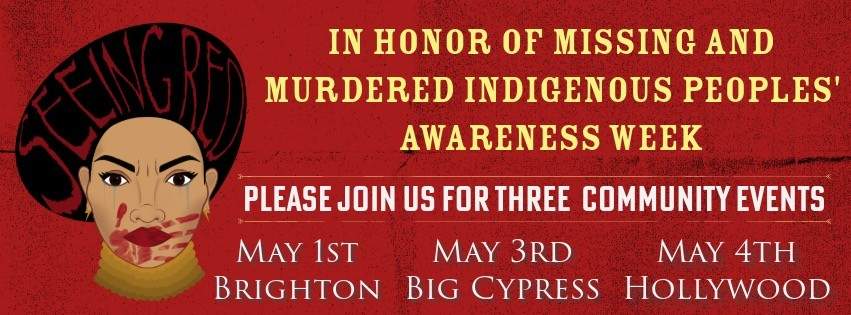
Snakes, Cinema, and Powerful Seminole Legacies at Silver Springs
Welcome back to our Seminole Spaces series! In this series, we explore places and spaces important to Seminole culture, history, and tourism. This week, we travel to Silver Springs, a tourist hot spot which featured many Seminole families over the years. It was once a prime destination on Florida’s tourist map.
Now, Silver Springs has now transformed into the beautiful Silver Springs State Park. During the early 20th century, Silver Springs, which included a Seminole Indian Village, exploded in popularity. But, did you know that the Seminole presence at Silver Springs went back much, much further than that? Follow along to learn more about Seminoles at the tourist attraction at Silver Springs. Additionally, we will explore Osceola’s defiant stand near Silver Springs that changed the trajectory of the Seminole Wars.
In our featured image, you can see tourists on the Silver River in Seminole Canoes. (Peithmann/State Archives of Florida)
Below, you can see a Seminole woman at Ross Allen’s Reptile Institute at Silver Springs on December 27, 1954. Two flamingos walk in front of her. The image is part of the Peithmann Collection, previously featured in our Seminole Snapshots series.
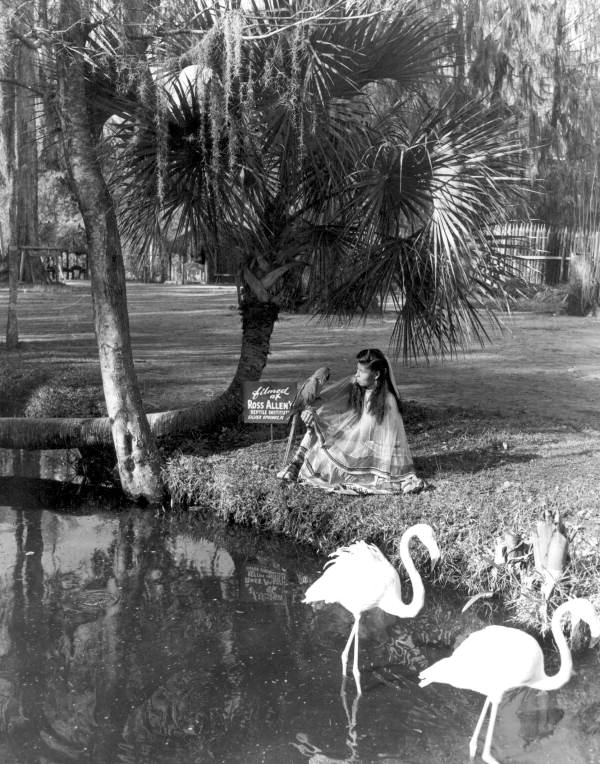
Peithmann/State Archives of Florida
The Historic Silver Springs
Silver Springs, a natural geological landmark, has attracted people for millennia. One of America’s largest natural springs, it “offers one of Florida’s premier views of clear groundwater flowing to land surface and an excellent example of the connection between rocks and water over geologic time.” In the 1820s, Silver Springs soon became an attraction for adventurous visitors. They would pole their way along the narrow stream. In fact, it was the first commercial tourist venture in Florida! After the invention of the steamboat, the attraction would gain even more attention. Soon, Silver River and the Springs would become a major distribution hub within Central Florida.
As nearby Ocala grew, tobacco, vegetable, and citrus farms would spring up along the Silver River. The famous glass bottomed boat tours began in the late 1870s. Phillip Morrell fixed a piece of glass to the bottom of a rowboat, and soon a brand-new enterprise was born. Thus, the Springs have now been world famous for the glass bottomed boat tours for over 100 years.
Cinema at Silver Springs
In the 1930s and 1940s, the Springs would also become a filming hotspot. Although the first movie to be filmed there was The Seven Swans in 1916, Silver Springs wouldn’t take off as a premiere filming location until the 1930s. During the 1930s and 1940s, six original Tarzan movies were filmed there, including the 1932 Tarzan the Ape Man. Additionally, other notable films include James Dean’s Rebel Without a Cause, Distant Drums with Gary Cooper, the cult hit Creature from the Black Lagoon, and the James Bond film Moonraker.
Later, it would also be used as a filming location for tv shows, including the popular 1958 series Sea Hunt. In 2019 Marlin Billie (Panther Clan) wrote a Seminole Tribune article which mentioned Seminoles at Silver Springs during this era. Billie writes that Silver Springs “became a place established by Seminole tourism and then changed into a movie set location which many Seminole families were a part of.”
Seminole History at Silver Springs
Like many places in Florida, the Seminole did not just start coming to Silver Springs when it became a tourist destination. In fact, Seminoles and Seminole ancestors have been living and travelling around the Springs, and the nearby Ocala area, for thousands of years. But, the Springs would also be the site of a significant moment in Seminole history. During the Seminole War period, the Springs were the headquarters for Seminole leader Osceola. Osceola was a beloved leader, and a fierce opponent of Seminole removal.
Osceola’s Defiance
Osceola launched a strategic and calculated attack on Fort King and Indian Agent Wiley Thompson in 1835. In a news article about the 1967 Seminole Pow Wow discussed below, they emphasize the historic Seminole connection to the area. It reads: “The ceremonies yesterday took place about three miles from the spot where Indian Agent Wiley Thompson was ambushed on Christmas Eve, 1835 by Osceola to begin the Seminole war which has never been ended. The site of the killing was just outside the gates of Fort King, which was erected to watch the activities of the Seminoles at Silver Springs.” (1 Oct 1967, The Tampa Tribune)
Additionally, annually in December, the fort hosts the Fort King Festival. It is a two-day event featuring historians, crafts, workshops, games, activities, and more. The pinnacle event is a dramatic reenactment of the event that fueled the start of the Second Seminole War, which features Seminoles as well as historic actors.
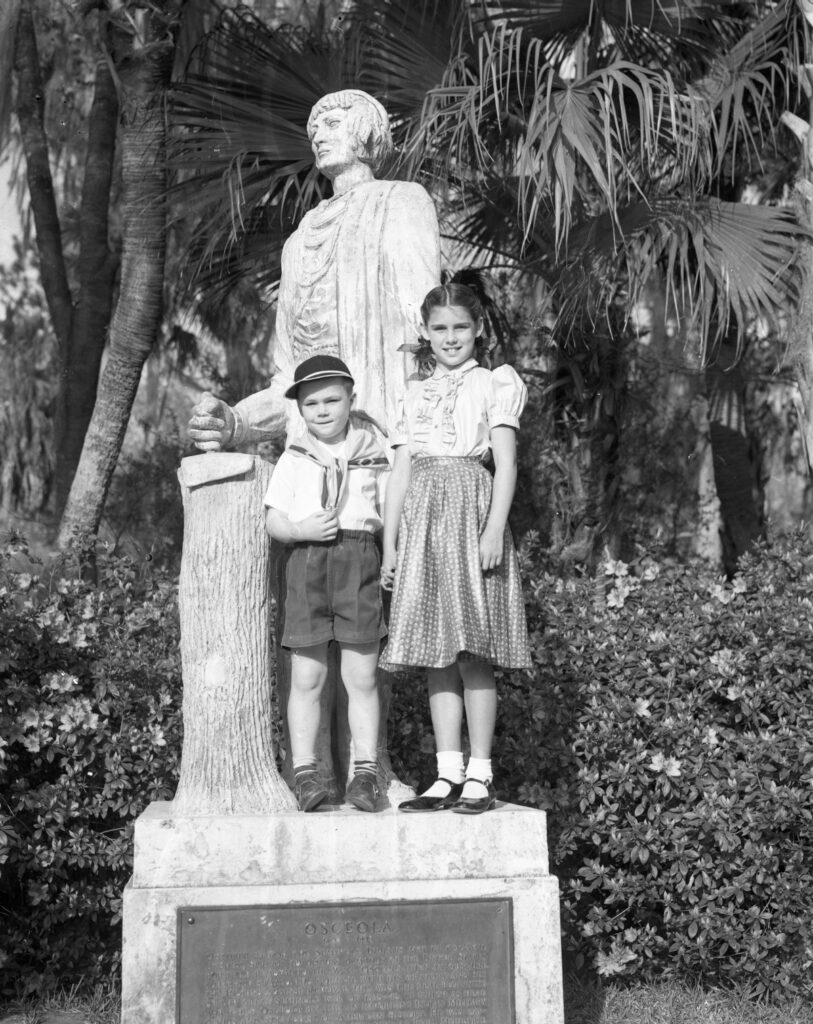
Mozert/State Archives of Florida
Here, you can see two children standing with a statue of Osceola at Silver Springs in 1950. Bernice West carved the statue. The accompanying text reads;
“October 23, 1834, the Seminole Indians met in council at these springs to discuss demands of the United States for their removal to the West. Osceola, then an obscure sub-chief, swayed the council with his oratory and set the Indians against removal. This was the real beginning of the Great Seminole War of 1835-42, in which, as head War-Chief, Osceola became an important Indian military genius and strategist of American history. He was captured through deception and died at Fort Moultrie, Charleston, January 30, 1838.”
The 1967 Seminole Tribe Pow Wow & Glass Bottomed Boat Dedication
In 1967, Betty Mae Tiger and Joe Dan Osceola organized a huge Seminole Pow Wow and Festival at Silver Springs. It also coincided with the Springs renaming their glass bottomed boats after a number of Seminole leaders. In a news article about the events, Betty Mae shared her hope that it could be a moment of growth for both the Seminole and white communities.
“Silver Springs has honored the Seminole by naming their boats for our chiefs in a manner that we think will bring greater understanding between our people and the citizens of Florida,” Betty Mae stated. “It is our sincere hope that the conclave at Silver Springs will serve to focus attention on our people, the customs, traditions, and history.” (15 Sept 1967, The Tampa Tribune)
The Pow Wow and festival, which lasted for two weeks, was one of the first large-scale off-reservation events. It was a rousing success.
After, Betty Mae remarked “What would Osceola say if he could see us gathered here today whites and Indians?” (1 Oct 1967, The Tampa Tribune)
Silver Springs Seminole Indian Village
As we have emphasized in previous posts, early Seminole tourism was a vital economic resource for Seminole families in the early 20th century. Development of the Everglades vastly changed the Florida landscape. Seminoles were forced to pivot to protect their way of life. Tourist camps, like the Silver Springs Seminole Indian Village, thus became important locations that highlight Seminole tenacity and resilience in the changing landscape.
Families would live, or travel for the season, in these camps. Tourists could see Seminoles sewing traditional patchwork, carving canoes, cooking, and generally living their lives in their traditional manner. Traditional arts and crafts like palmetto fiber dolls, baskets, patchwork, and wood carvings could be purchased for souvenirs. Below, you can see the entrance to the Silver Springs Seminole Indian Village, circa 1940.

State Archives of Florida
The village was under the management of Ross Allen of Ross Allen’s Reptile Institute. Allen was an American herpetologist, writer, and theme park entrepreneur. He founded Ross Allen’s Reptile Institute in 1929, which at some point also included the Silver Springs Seminole Village. The Institute featured both educational and research material, as well as animal exhibits such as animal wrestling and snake venom milking. In a 1960 Guided Tours documentary about the Institute, you can see Francis Osceola demonstrating Seminole alligator wrestling (3:17), along with parts of the accompanying village. Below, you can see an aerial shot of the Silver Springs Seminole Indian Village circa 1950.
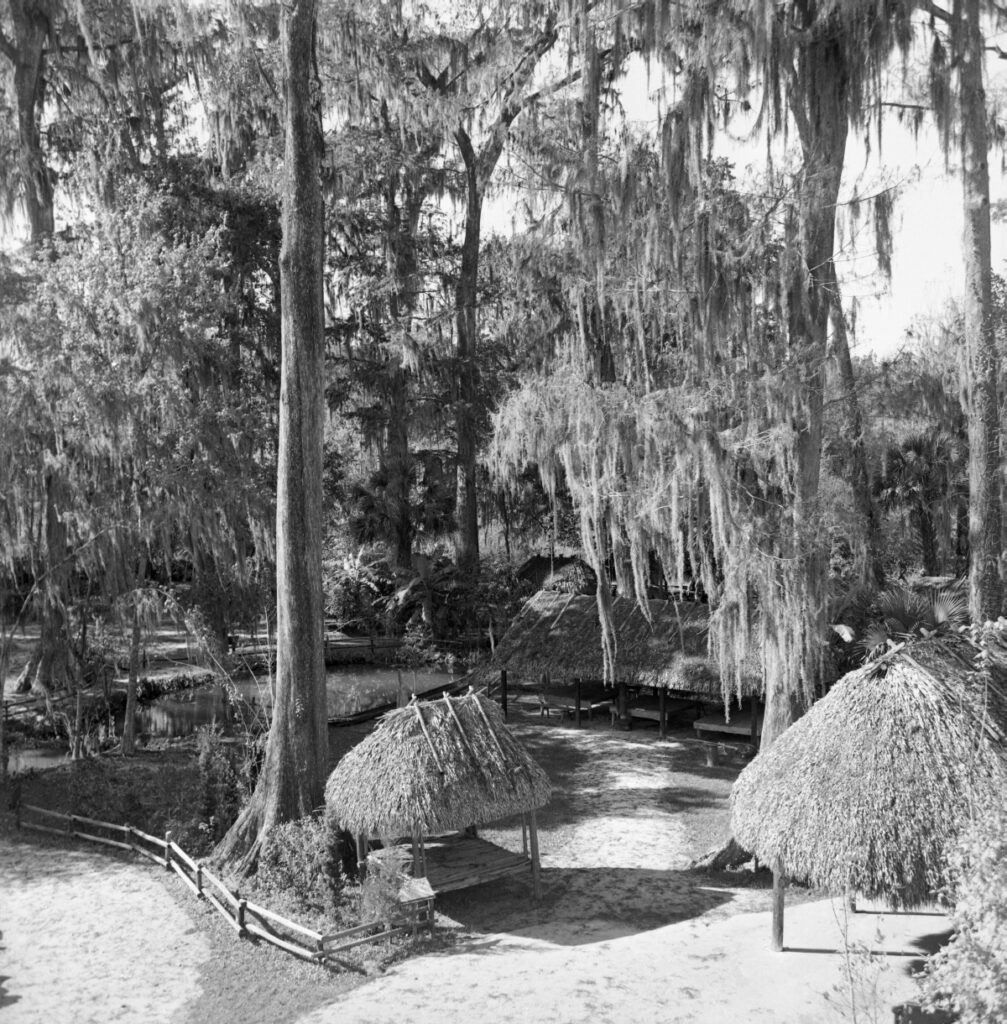
Mozert/State Archives of Florida
Lee Billie and Charlie Cypress
Two influential Seminole people who will forever be attached to Silver Springs are Lee Billie and Charlie Cypress. Below, you can see Lee Billie, Charlie Cypress, and their family on the Big Cypress Reservation on December 26, 1956. Their camp was located on Big Cypress, and in 2017 the Tribal Historic Preservation Office (THPO) began the to evaluate their camp for eligibility for the Tribal Register of Historic Place (TRHP). One criterion for adding a location to the Tribal Register is “a property that is important because of a contributing person or group in Seminole history.” The Lee Billie and Charlie Cypress camp definitely meets this qualification for eligibility. They were the headman and matriarch of the Silver Springs Seminole Village and worked tirelessly to help the Seminole Tribe maintain their culture and ways of life. They were both educators and cherished leaders within the community.
Charlie Cypress was a renowned canoe carver, traditional leader, and medicine man. In the 1930s, Cypress was part of a group that asked the Secretary of the Interior to grant them land in multiple counties spanning the Everglades, Cow Creek, and the Fort Drum Swamp. They also requested assistance with full-time Indigenous nursing to provide much needed healthcare (Seminole History Stories, February 2023).
Lee Billie was the family matriarch and maintained a traditional camp. She passed down traditional skills to the next generation, including cooking, sewing, and basket weaving. Together, they “did incredible work to preserve Seminole culture during a time of intense change and transition…their partnership helped the continuation of traditional customs, values, and the expansion of the land on which the Tribe continues to thrive today.” (Seminole History Stories, February 2023).
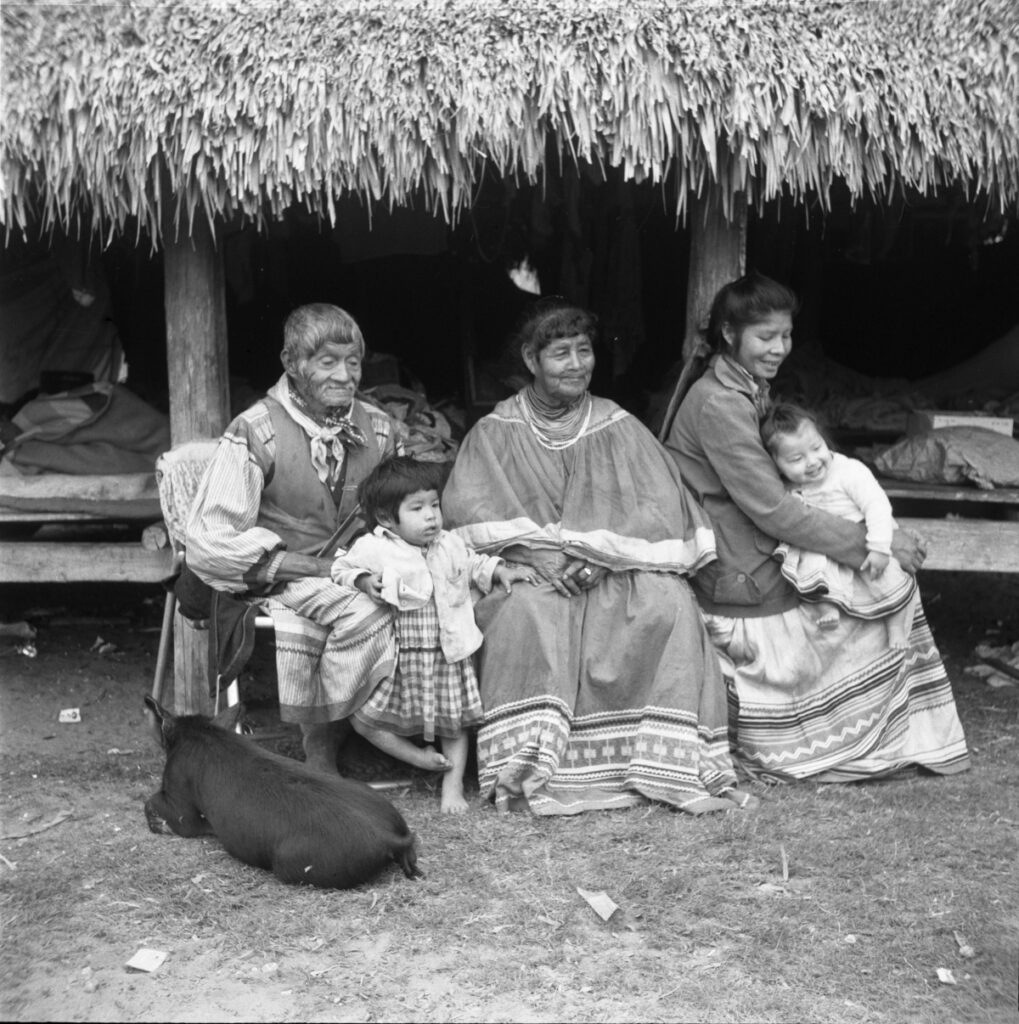
Peithmann/State Archives of Florida
Silver Springs State Park
Today, the land is now protected as Silver Springs State Park. In 2013, it came under the management of the Florida Parks Service, who merged it with the adjacent Silver River State Park. There is no longer a Seminole village located at the springs. But, visitors can hike, camp, kayak, canoe, and even join one of the famous glass bottomed boat tours! The Silver River Museum and Environmental Education Center is located on-site and contains two exhibit areas dedicated to the science and history of Florida and Marion County.
As always, we encourage you to explore these important Seminole places and spaces respectfully and thoughtfully, and remember how people, history, and places shift and change with time and perspective. Also, don’t forget to check back later for a new Seminole Spaces installment!
Author Bio
Originally from Washington state, Deanna Butler received her BA in Archaeological Sciences from the University of Washington in 2014. Deanna moved to Florida in 2016. Soon, she began working for the Seminole Tribe of Florida’s Tribal Historic Preservation Office. Deanna was the THPO’s Archaeological Collections Assistant from 2017-2021. While at the THPO, Deanna worked to preserve, support, and process the Tribe’s archaeological collection. She also often wrote the popular Artifact of the Month series and worked on many community and educational outreach programs. She lives in Lakeland, FL with her husband, two sons, and dog.



